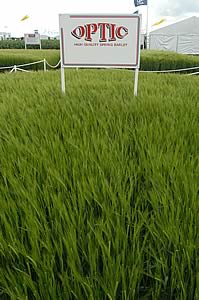| 2010-01-12
A Spring malting barley variety originally launched for brewing and distilling use – and which has remained one of the most-purchased varieties in Scotland for much of the last decade – is to celebrate fifteen years as a Recommended List variety in 2010.
With many hundreds of thousands of hectares planted since it was first recommended, Optic spring barley has remained a key feature in Scottish distilling, says Simon Phillips of Syngenta Seeds.
 |
Optic spring barley was first recommended in 1995, says breeder Syngenta Seeds, when it introduced an important step forward for growers, combining high yield with very high grain quality for malting.
In 2002 it went on to win the prestigious NIAB Cereals Cup – awarded to the variety that contributed the most technical advance toward improving UK farm profitability the previous year.
Subsequently, it went on to become Britain’s most popular spring malting barley variety purchased, says Syngenta Seeds head of product development Simon Phillips – at its peak rising to around three quarters of all spring malting barley purchased in England and almost two thirds of all spring malting barley purchased in Scotland.
Today, Mr Phillips says it remains the longest-listed variety on the current HGCA Recommended List of spring barley, and while little is now grown in England for brewing – having been superseded by higher-yielding brewing varieties such as NFC Tipple and Quench – he says recent figures showed it still remained a firm favourite for Scottish distilling.
“Optic still accounted for over 40% of the spring malting barley purchased in Scotland in 2008, which is the most recent year we have figures for,” says Mr Phillips. “Indeed, it actually saw an increase in purchases as some newer varieties saw a decline.”
While other varieties have come and gone during its lifetime, Mr Phillips says Optic in Scotland has pretty much been a constant.
“It’s one of those dependable varieties which come along every now and again which just seems to stand the test of time.
“It may not be the highest-yielding variety. In fact there are other promising distilling varieties, such as Publican and Forensic, which have a 6 or 7% yield advantage. But under Scottish conditions it does repeatedly seem to come up with the quality.
“For farmers, a key benefit seems to be that it has robust resistance to factors such as grain splitting and skinning and to pre-germination. In addition, growers have learned how to get the best from it after all these years – which counts for a lot
“For end users, it seems to have that important quality of performing well through malting and distilling processes.
“The distilling end market is very different to the brewing market in terms of quality requirements. Indeed, there’s an argument that the market has polarised more towards separate brewing and distilling varieties since the time that Optic was at its peak. Replacement varieties have to pass through a lot of different tests.
“Based on its consistency of quality I think Optic could still be around for a number of years yet. Ultimately, I only hope that its successor – whether Publican, Forensic or another distilling variety – is able to serve the industry so well.”
 SAC/HGCA Spring Programme for Growers of Grain and Oilseeds SAC/HGCA Spring Programme for Growers of Grain and Oilseeds
 BASIS Appoints Karl Bahn as New Technical Manager BASIS Appoints Karl Bahn as New Technical Manager
 Early Rust Infections Appearing, Wheat Growers Warned Early Rust Infections Appearing, Wheat Growers Warned

|




